How do you cook peas? Peas are cooked in the least possible amount of water and in just the time for them to become just tender.
The French cook peas in the water it takes to moisten lettuce leaves. Line a saucepan with damp greens and a few pea pods, pour in the shelled peas, and cover them with moist lettuce. Steam the peas over high heat for about 3 minutes or until they are al denté, just tender.
Be careful not to overcook peas. Boiling or long steaming will increase water absorption and cause the peas to become soggy and mushy. Both flavor and nutrients are sacrificed when peas are overcooked.
Also of interest:
- How to Prepare Garden Peas with No Recipe
- How to Cook and Serve Snow Peas
- How to Grow Peas
- How to Harvest and Store Peas
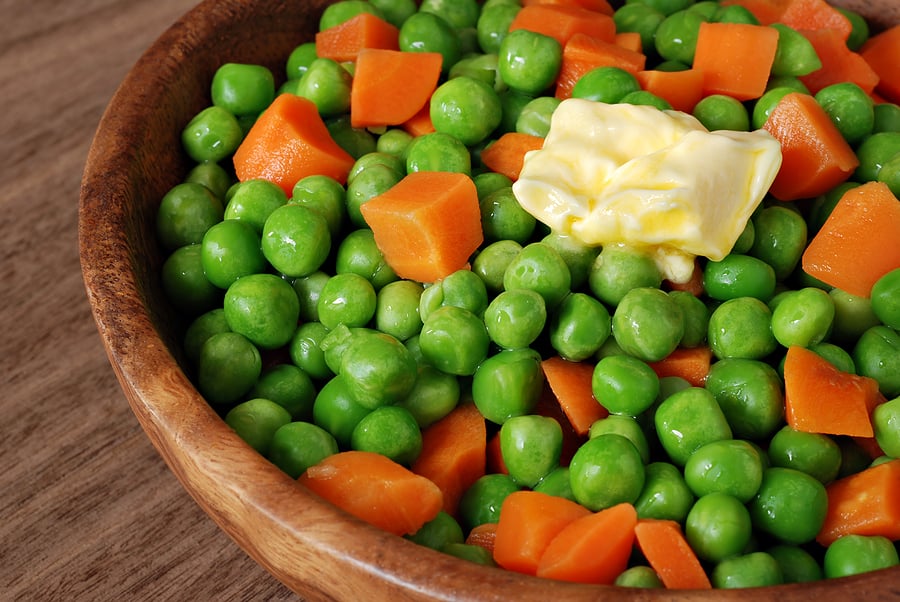
When the peas are ready, the simplest way to enjoy them is with butter, salt, and pepper.
Pea, garden pea, and English pea are all the same. The pea is traditionally the first kitchen garden crop planted each year. It goes into the ground as soon as the soil can be worked.
Kitchen Helpers from Amazon:
- EZ Off Jar Opener for Weak Hands
- Pepper Core Remover Stainless Steel
- Kitchen Utensils – Set of 35
- Rachel Ray Non-Stick Cookware 12pcs
When peas come to harvest, follow this advice: pick peas the instant that they are bright green and the pods begin to bulge. Split the pod open with your thumb and roll the small sweet peas into your mouth or into the bowl and immediately prepare and enjoy. Young, small, tender peas are the sweetest to eat.
Peas are much like corn as soon as they mature a chemical reaction occurs that causes the peas’ sugar content to decrease rapidly. A fresh, sweet, juicy pea can rapidly become starchy and hard. The same is true if the pea is shelled and then left on the kitchen counter or in a warm place for more than a few hours.
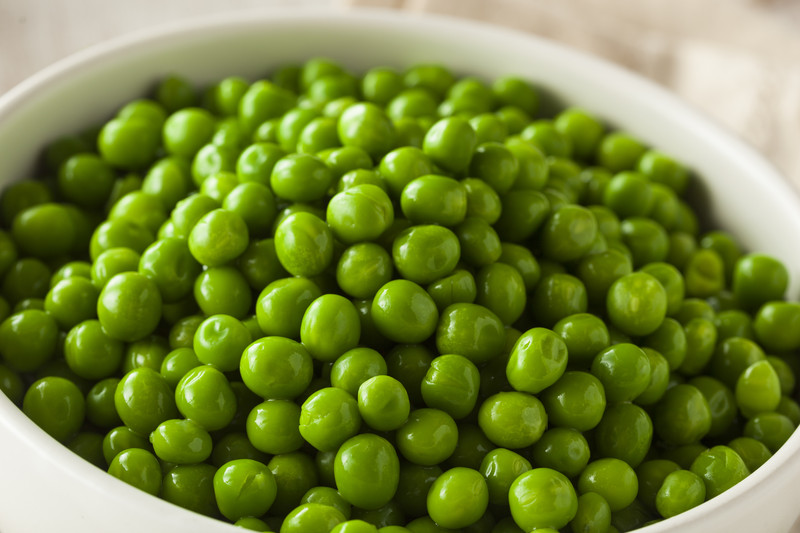
Two pounds of peas in the shell will give you about two cups of shelled peas. That is enough to serve three or four people.
Early peas are harvested from late spring to early summer and the main crop is harvested from midsummer to early fall. Peas require 55 to 70 days from sowing to harvesting and they won’t thrive if the soil temperature climbs much above 75°F (24°C). So if your growing season is long enough and the weather doesn’t grow too hot, you might get a mid-season pea crop as well.
Garden peas—also commonly called English peas or green peas—are one of the first vegetables harvested in spring. They are best picked as soon as the pods fill out and the peas inside are fat and round.
Petit pois or baby peas are small-seeded garden peas. They include peas that are simply picked very early but also include some pea cultivars that are genetically smaller than others. Petit pois, known by gourmands for their tenderness and sweet flavor, is a delicacy in France.
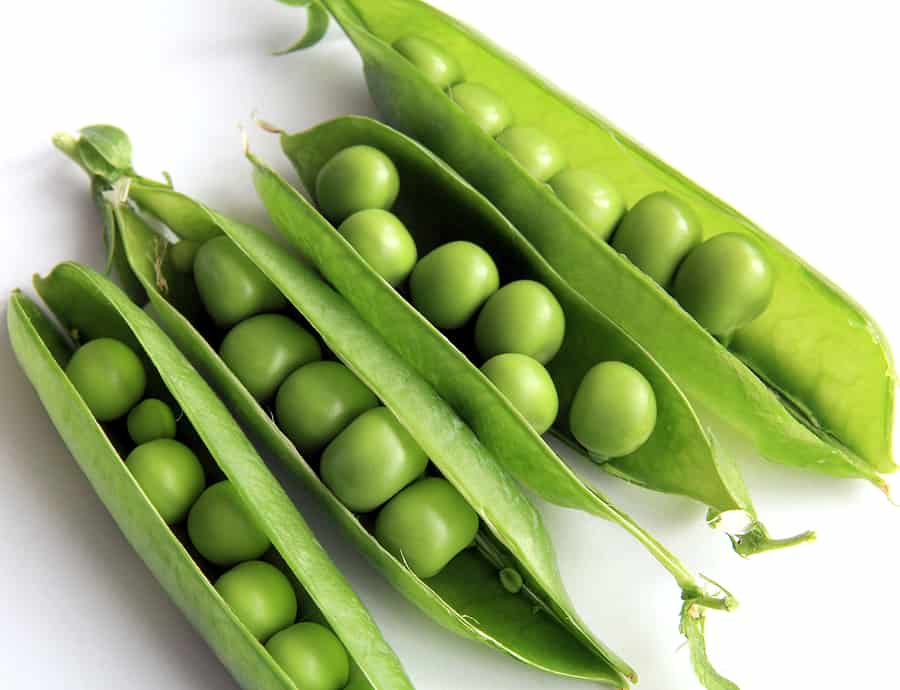
About shelling peas
There are two kinds of peas: shelling peas that are shelled and the seeds are eaten either fresh or dried, and edible pod peas, peas that can be eaten whole–pod and seeds together–or shelled and the seeds eaten alone.
- Shelling peas are valued for their seeds. Shelling peas are also called garden peas, green peas, baby peas, early peas, English peas, June peas, and by the French name petit pois. The seeds of the shelled pea are best eaten fresh shortly after they have been picked and shelled.
- Garden peas for shelling have parchment-like pods that are too stringy to eat. That’s why they are best shelled. (But you can add unshelled garden peas to soup broth for flavor.) Shelled garden peas are also called fresh peas. Shelled garden peas have wrinkled seeds and high sugar content. They are usually cooked as a vegetable.
- Shelling peas also include field peas that are left on the vine to mature and dry. Later these peas are harvested and shelled. Field peas have smooth, hard seeds and are easily stored. Smooth seeds are starchy and are most often used whole or split into soups, stews, or cooked and eaten plain.
- Common field peas are either yellow or green and are grown specifically for drying. Other field peas are the black-eyed pea, chickpea, and cowpea or southern pea.

About edible-pod peas
- Edible-pod peas can be eaten whole, both seed and pod. Sugar snap peas and snow peas are edible-pod peas. Edible-podded peas can be served fresh or briefly cooked so that they don’t lose their crisp texture.
- Snow peas have translucent, bright green pods that are thin and crisp. Their seeds are tiny, tender, and sweet. Snow peas are known for their crunchy texture and sweet flavor. Snow peas are also called Chinese snow peas or mange-tout, a French term which means eat-all. Snow peas were developed in Holland. They were originally called Dutch peas, not Chinese snow peas.
- Sugar snap peas—also called sugar peas–are a cross between English or garden peas and the snow pea. Sugar snap peas look like English peas (garden peas) but they are smaller, smooth, and curved, and they are sweet and crunchy with an edible pod like a snow pea. Sugar peas can be eaten either whole or shelled.
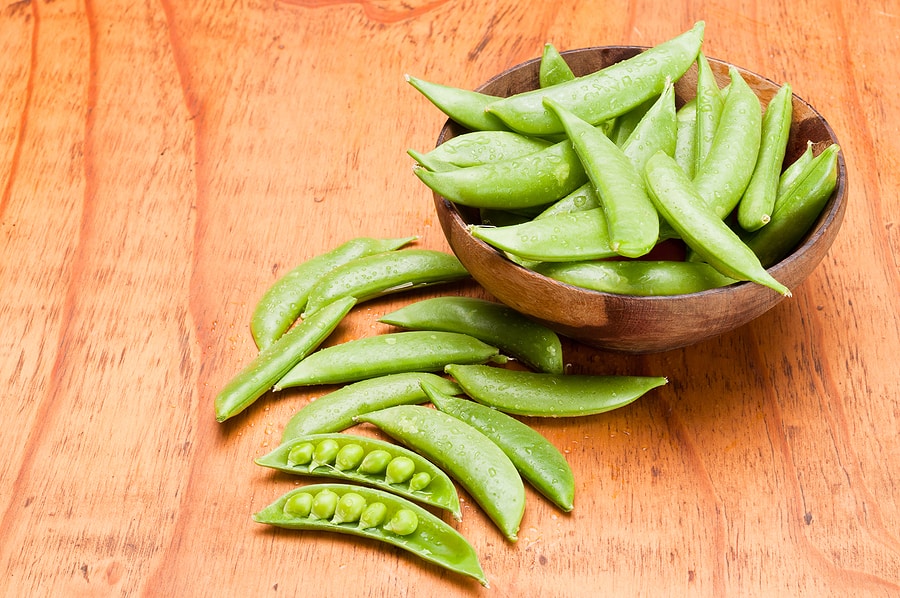
How to choose peas
- Peas for shelling should have a swollen cylindrical shape and should be bright green.
- Shell peas immediately after harvest for the sweetest flavor.
- Edible-podded peas are best harvested when they are 2-3 inches (5-7.5cm) long and before the seeds begin to swell.
- Field or dried peas will have withered or yellowed pods at harvest.
- Select peas that have plump, unblemished, bright green pods.
- Peas in the pod should be glossy, crunchy, and sweet.
- The pods should be plump but not bulging. Peas in a bulging pod will be too mature.
- Peas are ripe when the seam on the side of the pod has gone from convex to concave.
- Avoid pea pods that are dull looking or rattle when shaken. The peas inside will be old and have lost moisture. Avoid peas with yellowish or gray speckles.
- Break a pod open and taste a pea. It should be sweet, not starchy.
- Shelled garden peas should go directly to the table with only a brief stop at the stove. The sweetness of the peas is at stake.
- The conversion of the pea’s natural sugar to starch begins immediately after harvest. Some cooks say the greatest lag time between picking and serving peas should be no more than 12 hours. If you serve properly stored peas within a day or two of harvest, you should still find them a treat.
- Garden peas are peas out of the pod eaten as a green vegetable. Peapods are parchment-like and too stringy to eat. Garden peas along with field peas are also known as shelling peas because the pods are removed before eating.
- But all garden peas which are eaten when they are fat but still soft will be a sweet treat. Depending upon the variety, garden peas ready for harvest will measure from 1¾ to 6 inches (4-15 cm) long and contain between two and ten seeds of varying sizes. Seeds are generally round but also can have a slightly square form. Most garden peas are green but some varieties may be grayish, whitish, or brownish.
How to store peas
Peas that you are going to hold onto before eating should not be shelled. Set them uncovered in the coldest part of the refrigerator until you are ready to shell them. Rinse peas before you shell them not after.
If you are leaving peas in the refrigerator overnight or a day or two, they will still be tasty, but not as sweet as if you used them within two hours of harvest. If you get peas at the market, check to see when they are harvested. Farm market peas are usually sold the day after harvest.
- Unshelled peas will keep in a plastic bag in the refrigerator for 1 to 3 weeks.
- Shelled peas will keep for one week in the refrigerator.
- Shelled peas not used immediately should be cooled as quickly as possible to 32ºF (0°C) to prevent the conversion of sugars to starch.
- Dried peas can be stored in a cool, dry place for 10 to 12 months.
- Refrigerate peas in pods unwashed in a plastic bag for no more than 2 days.
- Shelled peas can be kept in the refrigerator in a sealed plastic bag for 2 days.
- Shelled, blanched peas can be frozen for 2 months.
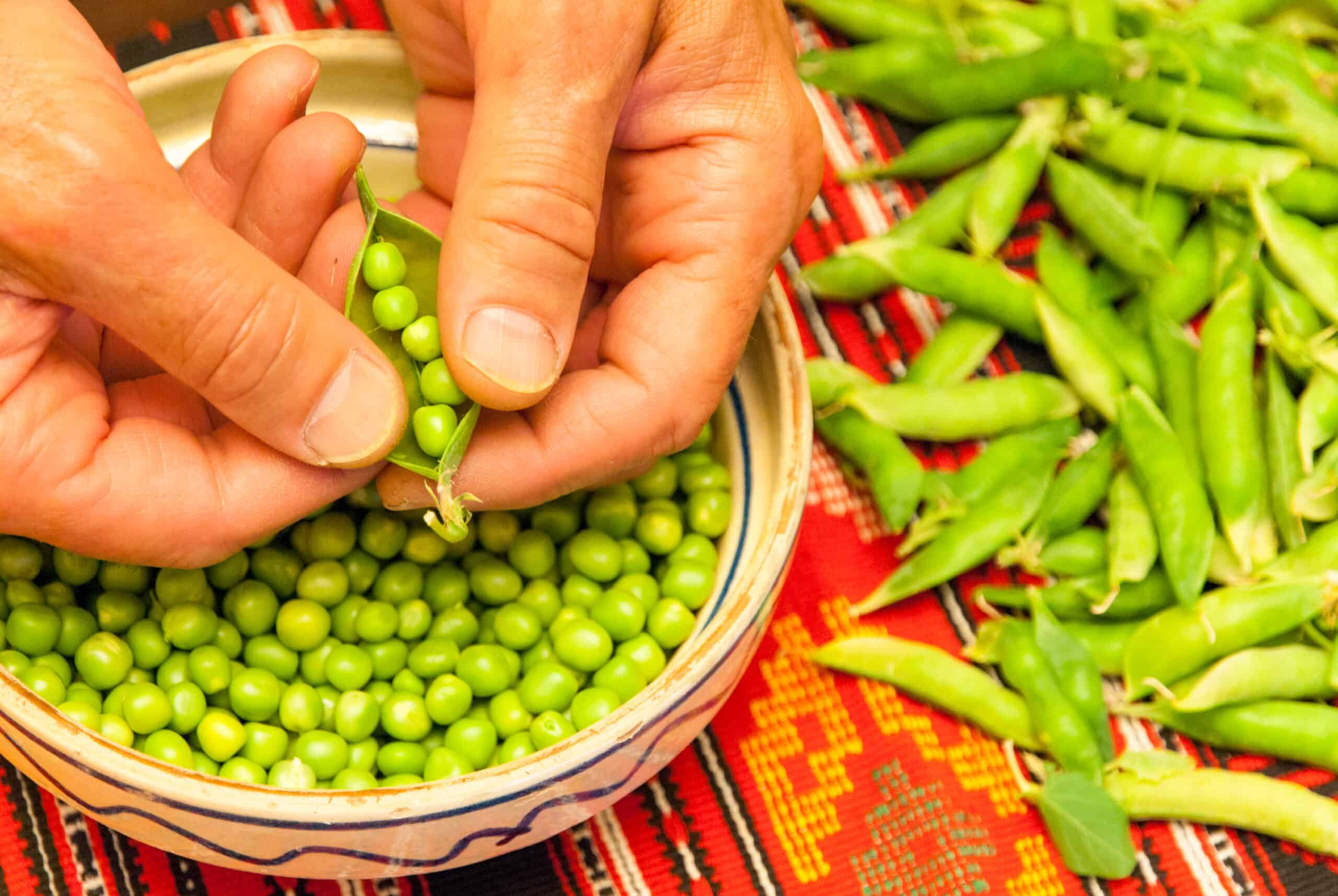
How to prepare peas
- Shell garden peas just before using.
- Rinse peas under running water before shelling; snap off the stem end of the pod; pull off the string along the seams. Do the same at the other end, and pry the pod open to remove the seeds.
Favorite peas recipes
Englis Peas, Spring Onions, and Roasted Almonds
Baby Beet, Baby Carrots, and Sugar Snap Peas Salad
Peas serving suggestions
- Serve peas within hours of harvest otherwise, the sugars will start turning to starch. Peas can be served raw or cooked.
- Boil or steam fresh peas in a minimum amount of water in a covered saucepan for 30 seconds to 1 minute but no more than 3 minutes. Overcooked peas will be mushy.
- Use fresh, raw, sweet English peas tossed into salads.
Snap peas serve suggestions
- Sugar snaps can be served raw or only briefly cooked in order to retain their crisp, crunchy texture.
- Blanch sugar snaps in boiling water for 30 seconds before stir-frying or using in salads.
- Quickly boil sugar snap then toss with butter or herbs or herb butter.
- Serve sautéed sugar snaps as a side dish for fish, poultry, pork, beef, veal, or in salads.
- Stir-dry snap peas with shrimp and serve hot with rice.
- Toss snap peas with shrimp, rice, and vinaigrette and serve chilled.
- Add snap peas to stews just before serving.
- Batter-fry snap peas as tempura.
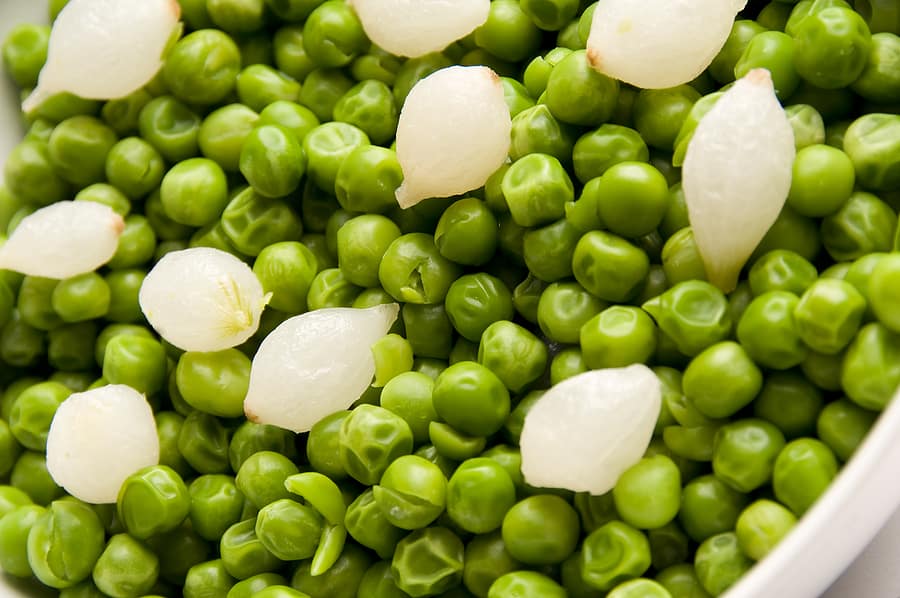
Peas cooking suggestions
Cooked peas can accompany meat and poultry dishes. Peas are good with delicate meats such as veal or veal sweetbreads. Use peas in soups, stews, omelets, frittatas, and pasta dishes.
- Braise peas in stock with lettuce. French cooks add shredded lettuce to steaming peas. You can also add onion or green onion.
- You can braise peas between two layers of rinsed lettuce leaves. Italian cooks braise peas with prosciutto. Indian cooks braise peas with cubes of firm cheese.
- Mix peas with carrots or corn and serve hot. Combine peas with asparagus spears.
- Serve fresh, cooked peas with boiled potatoes.
- Serve just steamed or boiled peas buttered with a sprig of mint.
- Steamed peas can be cooled and then tossed with diced ham and mayonnaise for a summer salad. Add cold, cooked peas to mixed salads or potato salad.
- Serve peas in cream sauce with pearl onions, celery, or carrots.
Frozen peas processed just after harvesting most closely mimic fresh peas in color, flavor, and nutritional value.

How to boil peas
- Shell the peas.
- Place the peas in a saucepan and just cover them lightly with salted water.
- Boil briefly until the peas are just tender and bright green, about 2 to 3 minutes.
- Drain the peas.
- Melt the butter in a skillet over low heat
- Add the peas to the butter and toss; salt and pepper to taste.
- Serve hot.
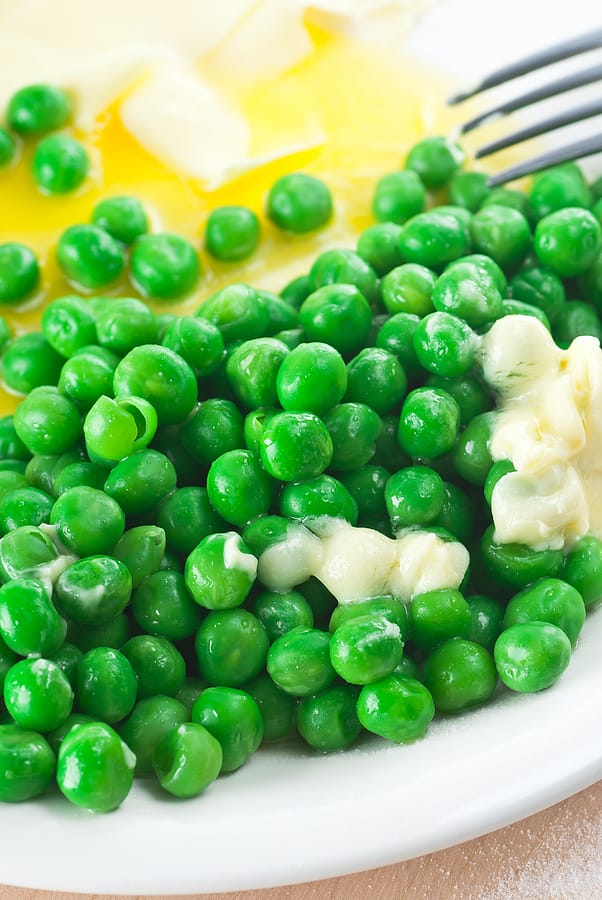
How to braise-sauté peas
- Shell green peas, about 3 pounds.
- Wash a head of leaf lettuce but do not dry it.
- Melt a stick of unsalted butter in a 2 to 3-quart saucepan then cover the bottom of the pan with damp lettuce leaves.
- Put the peas on top of the lettuce and sprinkle with salt and pepper to taste and a teaspoon of sugar. Place damp lettuce leaves on top of the peas. (The lettuce creates steam and liquid.)
- Cover and cook over low heat until the peas are just tender, about 20 to 25 minutes.
- Serve the peas with or without the lettuce.
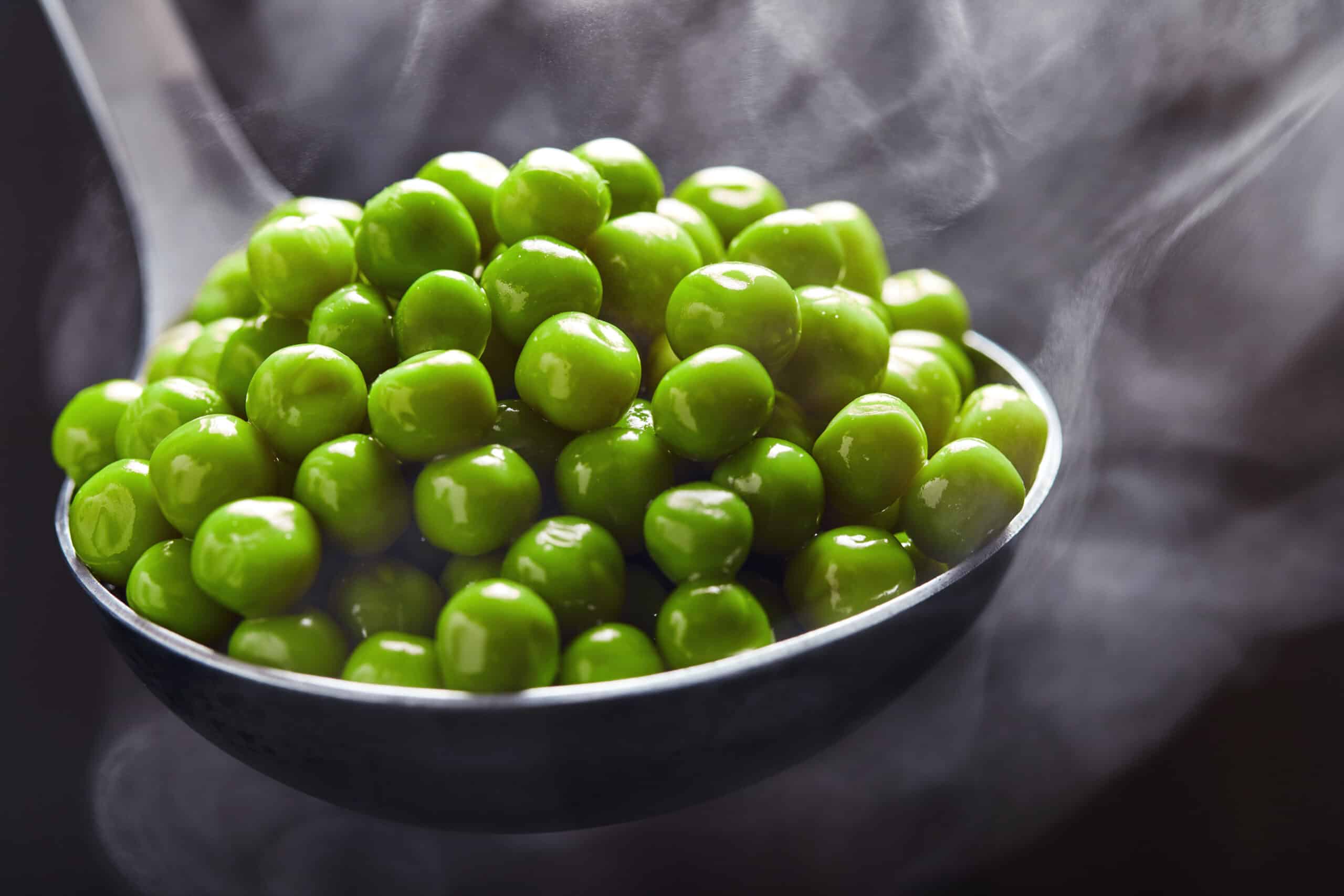
How to steam peas
- Shell the peas.
- Place an inch of water into a saucepan. Put a steamer basket over the water; be sure the water does not touch the basket.
- Put the shelled peas in the basket.
- Bring the water to a boil, then cover the pot.
- Cook until the peas art tender and bright green, about 2 to 4 minutes.
How to microwave peas
- Shell the peas.
- Place the peas in a microwave-safe dish with a tablespoon of water.
- Cover with a lid or paper towel and cook on high for around 3 to 4 minutes.
- Stir the peas and cook until tender, about 3 to 5 minutes more.
- Drain the peas and serve hot.
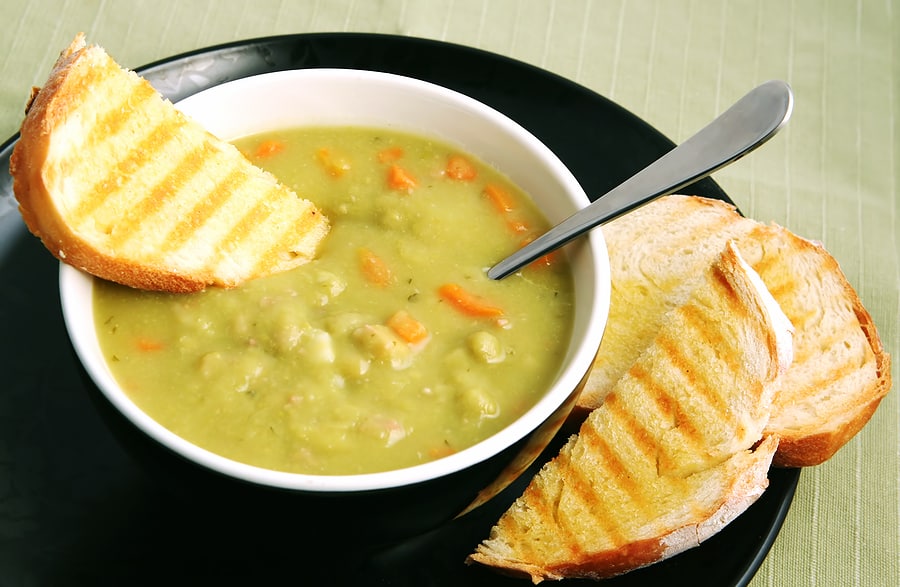
Snap peas cooking times
- Steam snap peas for about 4 minutes.
- Simmer snap peas for 2 to 3 minutes.
- Boil snap peas for 2 minutes.
- Stir-fry for 2 to 3 minutes.
- Oven steam sliced sugar snaps in foil or parchment for 6 to 7 minutes, whole 9 minutes.
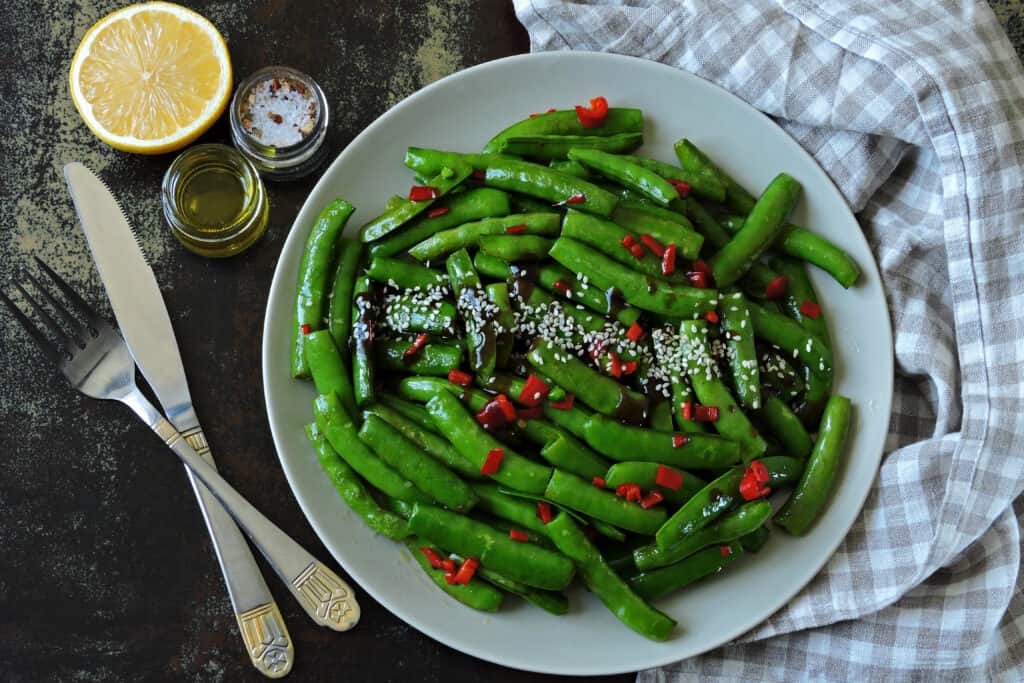
Peas flavor partners
- Serve peas with artichokes, chervil, chives, crabmeat, lettuce, mint, salmon, scallions, scallops, shad, shrimp, sorrel, or tarragon.
Peas nutrition
- Peas are a good source of folic acid, potassium, thiamine, and magnesium and contain vitamins A, B, and C.
- Peas contain niacin and iron.
- Peas are low in calories.
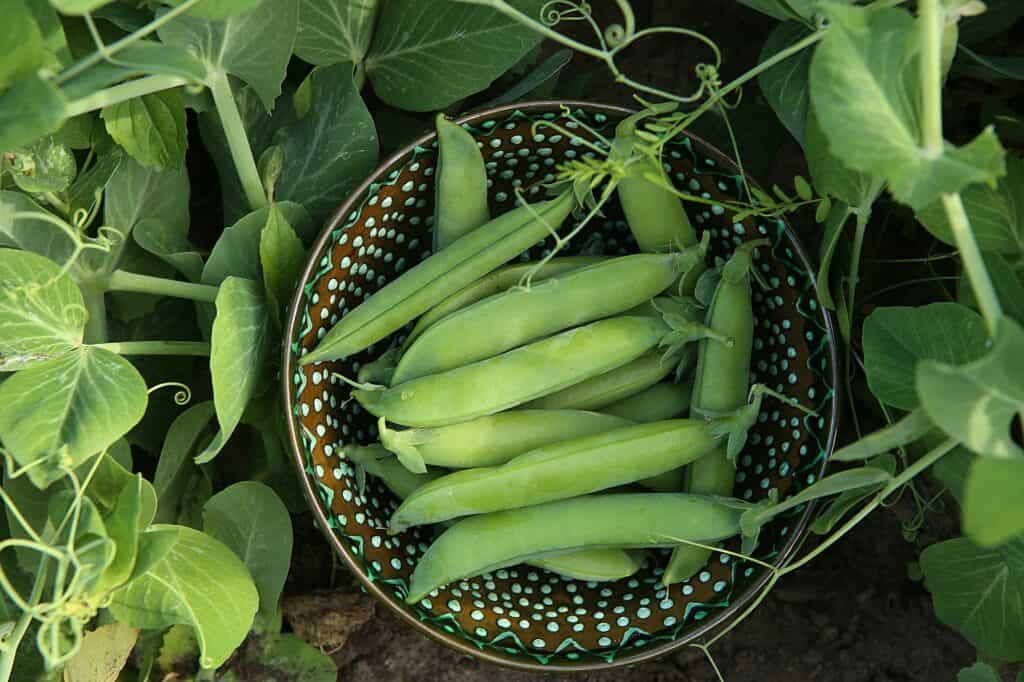
About snap peas
- The snap pea is a medium to dark green pea and is best harvested when the pod is 2½ to 3 inches (6.4-7.5 cm) long.
- The snap pea is a cool-weather vegetable. It is most flavorful when planted and harvested either in the spring or the fall.
- The snap pea is a cross between a garden or English pea and the snow pea. It resembles the English pea, but its pod is smaller and curved.
- Snap peas are wholly edible like snow peas, but the flavor is sweeter.
- Snap peas, unlike snow peas, have the best flavor when the peas have formed inside the pod.
- The snap pea is a relatively new pea. Although sugar peas have been around since the seventeenth century, the sugar snap—many varieties are stringless!–was perfected in the late 1970s.
The botanical name of sugar snap peas is Pisum sativum var. macrocarpon.
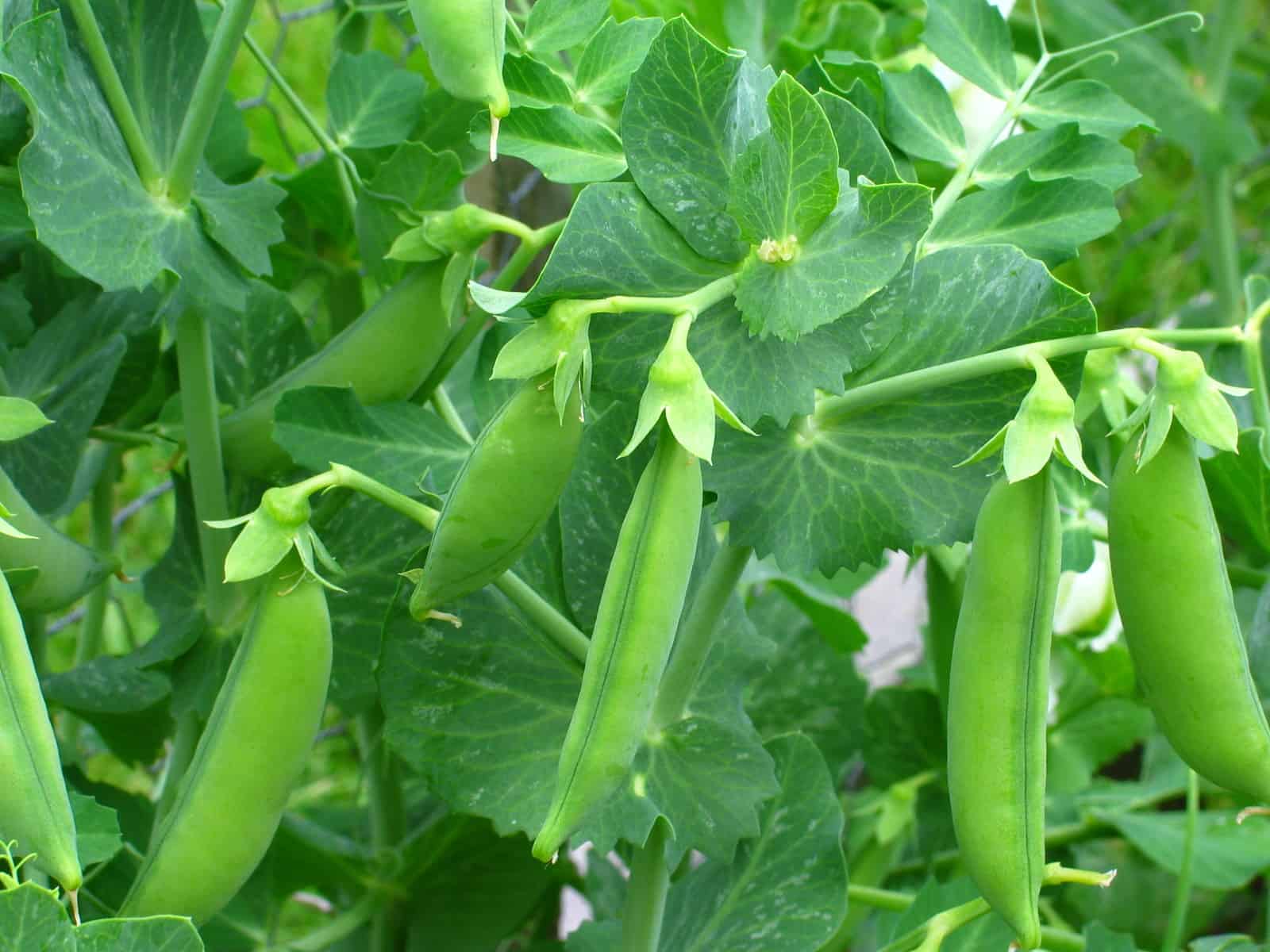
About peas
- Peas have oblong pods that contain up to ten round seeds. Most garden pea cultivars have flowers that are white. Peas with flowers that are pink and purple are used for making dry peas or split peas.
- Peas are an annual crop that originated in the eastern Mediterranean region, probably in ancient Persia. The cultivation of dried peas began more than 8,000 years ago. Green peas and edible-podded peas–such as snow peas and sugar snap peas—are more recent developments.
- Garden peas in addition to being known as green peas or English peas are also sometimes called baby peas, early peas, June peas, and by the French name petit pois.
- Garden peas are descended from field peas and are the product of centuries of cultivation and selection. The Greeks and Romans cultivated shelling peas for drying. Renaissance gardeners were the first to cultivate sweet green peas.
- The cool climate of England is perfect for growing peas. The sophistication of peas growing in England and the development of new varieties there resulted in garden peas being dubbed English peas.
- Peas are legumes. Legumes are plants whose seeds are borne in pods. Legumes include peas, beans, and peanuts.
- Peas are a cool-weather annual. They are planted just before the last frost and are harvested early in spring—called “early peas”, and late in spring—called “late early” or “maincrop peas.” Peas are also planted and harvested later in the year before the first frost in fall.
- Under cool temperatures, garden peas do not mature rapidly and can be harvested for several days. But when the weather warms, pea seeds accumulate starch rapidly and should be harvested and eaten quickly.
- Peas originated in Persia about 12,000 years ago. The earliest peas grew wild in bogs and were as large as marbles.
- From Persia, peas spread to Asia Minor, Palestine, Greece, and Rome, and from Rome to Britain and Europe.
- In classical Greece, peas were known as pison. Peas were a principal food for the poor during medieval times. The Old English word for peas was peason. In the eighteenth century, peason was shortened to peas.
- Dutch farmers during the sixteenth century were the first to develop small, sweet, tender garden peas. Those peas became a culinary craze in England and France during the seventeenth century.
- The English liked garden peas so much that they became known as English peas.
- The French gave ordinary peas harvested young the French name, petits pois.
- There are more than 1,000 varieties of peas.
The botanical name for English peas is Pisum sativum.
Peas rlated articles on Harvest to Table:
How to Cook and Serve Garden and Snap Peas
How to Prepare Spring Peas with No Recipe
English Peas, Spring Onions, and Roasted Almonds
Baby Beets, Baby Carrots, and Sugar Snap Peas Salad
How to Cook and Serve Snow Peas
Garden Planning Books at Amazon:
- Tomato Grower’s Answer Book
- Vegetable Garden Almanac & Planner
- Kitchen Garden Grower’s Guide Vegetable Encyclopedia
- Vegetable Garden Grower’s Guide
More kitchen tips:
Bring your harvest to the table. Kitchen prep tips and easy recipes for the vegetables you grow. Click below for vegetable prep and recipes you can use now.
- Almonds
- Apples
- Apricot
- Aprium
- Artichoke
- Arugula
- Asparagus
- Avocado
- Bamboo Shoots
- Banana
- Basil
- Beans, Dried
- Beans. Long
- Beans, Shell
- Beans, Snap
- Beets
- Bitter Melon
- Blackberry
- Bok Choy
- Broccoli
- Broccoli Raab
- Brussels Sprouts
- Cabbage
- Cardoon
- Carrots
- Cauliflower
- Celeriac
- Celery
- Chard
- Chayote Squash
- Cherimoya
- Cherries
- Chestnut
- Chickpea
- Chinese Cabbage
- Chives
- Cilantro
- Citron
- Clementine
- Collards
- Coriander
- Corn, Sweet
- Corn, Baby
- Corn Salad, Mache
- Cranberry
- Cress
- Cucumber
- Daikon
- Dandelion
- Dill
- Eggplant
- Endive, Belgian
- Endive and Escarole
- Fava Beans
- Fig
- Florence Fennel
- Garlic
- Ginger
- Grapefruit
- Grapes
- Guava
- Horseradish
- Jerusalem Artichoke
- Jicama
- Jujube
- Kale
- Kiwifruit
- Kohlrabi
- Kumquat
- Leeks
- Lemongrass
- Lemons
- Lettuce
- Lime
- Mache (Corn Salad)
- Mandarin Orange
- Mango
- Maple Syrup
- Marjoram
- Melons
- Michihili
- Mint
- Mizuna
- Mushrooms
- Mushrooms, Cremini
- Mustard Greens
- Napa Cabbage
- Nectarine
- Okra
- Olives
- Olive oil
- Onions
- Oranges
- Oregano
- Parsley
- Parsley Root
- Parsnips
- Passion Fruit
- Pawpaw
- Peaches
- Pears
- Peas, Garden Snap
- Peas, Snow
- Pei Tsai
- Peppers, Chili
- Peppers, Sweet
- Persimmon
- Pineapple
- Pineapple Guava
- Plantain
- Plums
- Pluots
- Pomegranate
- Potatoes
- Prickly Pear
- Pumpkin
- Quince
- Radicchio
- Radishes
- Raspberries
- Rosemary
- Rhubarb
- Rutabaga
- Sage
- Salsify
- Sauerkraut
- Savory
- Shallots
- Sorrel
- Spinach
- Squash, Summer
- Squash, Winter
- Strawberries
- Sunchokes
- Sunflower
- Sweet Potato
- Swiss Chard
- Tangerine
- Taro
- Tarragon
- Thyme
- Tomatillo
- Tomato
- Turnip
- Turnip Greens
- Yams















